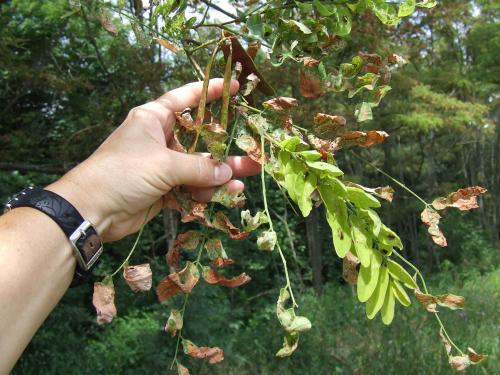Locust leaf miner cause of browning roadside trees
Small insect causes leaves on black locust to turn cinnamon-brown but does not cause harm to tree health.

Dramatic browning of black locust, a common roadside tree in the lower peninsula of Michigan is being caused by a small leaf-mining beetle (Odontota orsalis.) This small (one-eighth of an inch long), colorful beetle deposits eggs inside black locust leaves where the larvae feed, creating leaf mines that eventually turn the leaves brown. Heavy infestations cause entire trees or groups of trees to turn brown.
“If this has happened to trees on your property, don’t panic and cut them down,” says David Smitley of Michigan State University Extension. Late season browning or defoliation may weaken trees, but it rarely kills them.
Infestations tend to be every couple of years but one site in Grand Rapids, Michigan has had the damage nearly every year with no ill effect to the trees themselves. With a native range from Pennsylvania to Georgia, black locust is a very adaptable plant with dense hard wood that will survive even the toughest conditions. It can be easily found in Michigan and older stands can be quite beautiful when in bloom.
Chemical control measures can be taken very early in the spring with some success, however it might be best just to wait it out.
Locust Leaf Miner damage to Black Locust foliage. Photo by Rebecca Finneran | Michigan State University
For more information on a wide variety of Smart Gardening articles, or to find out about Smart Gardening classes and events, visit www.migarden.msu.edu.



 Print
Print Email
Email



